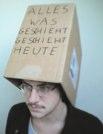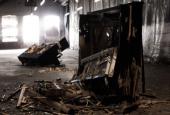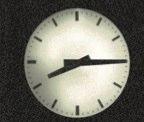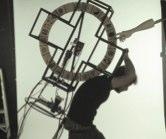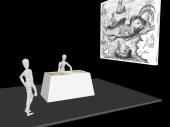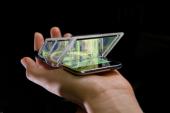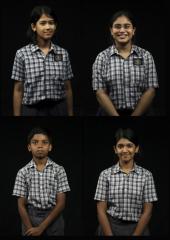-
ALLES WAS GESCHIEHT GESCHIEHT HEUTE
/ ALLES WAS GESCHIEHT GESCHIEHT HEUTE
The performance consist of the following elements: A poster (60x80, same as the image for the catalogue), a clock (whitout the arms but it is still ticking) and a cardboardbox. The poster and the clock are attached to the wall at eyelevel. In front of it I will put the cardboardbox (I will remove it from my head) and step on it. (Than it crushes) And I will say aloud with changing volume and rythm ›ALLES WAS GESCHIET GESCHIEHT HEUTE‹. After the performance the clock, poster and cardboardbox stay as an installation.
Director/author: Nick Defour
Belgium 2011
Expanded Media min.
-
AT 250 MILES PER HOUR
/ AT 250 MILES PER HOUR
Rick, Sylvia and Tim, three middle-aged persons, wanting to get away from boredom, decide to pursue the crazy dream: to go and bomb a boom in the west side of the United States.
During their journey from East to West, they will realise that it is impossible to return to the life they had before, and to get back to society. Inspired by Jim Harrison’s ›A good day to die‹.
Director/author: Felix Porato
France 2010
Installation min.
-
BLANK SCREENS
/ BLANK SCREENS
The multi channel installation ›Blank Screens‹ results of a research about landscape and moving images. It shows different places where images are directly involved in the landscape through a screen, mostly drive-in theaters, abandoned or opened. The serie is a witness of the position and the projection of images in a context, a setting, a landscape, a particular place and the power it exercises over the place (traffic, maintenance or abandonment of the place, advertising or media ...).
These short videos have been shot in different countries with the ideas of transit, roaming and wandering. Images in these videos seem to be absent through blank or suggested screens.
Director/author: Justine Emard
France 2011
Installation min.
-
BORDERLINES
/ BORDERLINES
georg klein usually works in public places with everyday situations in which he intervenes with an installation, artistically compressing it and charging it politically so as to create a ›tension-ridden space‹. The four works selected for the Galerie écart address a special tension-ridden space: borderlines and the crossing of them. The English term borderline roughly signifies a boundary line or border area. The borderline personality disorder (BPD) is in fact the most frequently diagnosed personality disorder. It is characterised by a disturbed relationship pattern, aggressive behaviour towards oneself and others, as well as excessive or risky behaviour. (From: ›Grenzgänger zwischen Extremen‹, Helwi Braunmiller)
These borderlines are also tested out on the audience in a highly provocative manner that consciously leaves the frame of art. In the project Watchtower : European Border Watch an organisation was established to recruit volunteers to patrol the European external frontiers in search of illegal immigration (www.europeanborderwatch.org). In Ramallah Tours a Palestinian taxi was positioned in Israel to advertise for a travel agency that books journeys from Israel to Palestine: ›safe & easy‹ (www.ramallahtours.info). Both of these two projects work with an installative, local object in a public place and a global, media object to create an irritating fake. They can be seen at the gallery in a newly developed form of documentation (›soundpicdoc‹), which presents not only the visual and tonal but also the media component of these projects in a compressed form.
The other two exhibited works, however, are more like interior views that deal with the individual forms of crossing borderlines: the dual audio-video-text installation Cuts and Creeds, projected into both windows of the gallery, leads us to the inner world of Muslim suicide bombers and western spree killers, whilst the installation Make me wild traces the movements of a black African illegal migrant in Naples.
Director/author: Georg Klein
Germany 2011
Installation min.
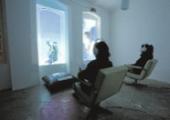
-
CAR/CIRCLE OF FOURTHS
/ CAR/CIRCLE OF FOURTHS
Car (2010, Wevelgem) and Circle of fourths (2009, Gent) are two films, each is set in a closed, one-space environment (microcosmos). Central to both films are the possibilities presented in these two self-created systems. I want to explore the process of formation. How does one element produce the other, how can one actor produce the other?
Director/author: Gertjan Bisschop
Belgium 2010
Installation min.
-
CLUSTER
/ CLUSTER
When smoke rises into the air, it’s visible from a great distance. An event inscribes itself into the sky for a brief time. Indigenous North Americans in particular are said to have made practical use of this, sending information with the aid of smoke signals. When making CLUSTER Rainer Gamsjäger created a ten-meter column of smoke and filmed it on videotape. This served as the raw material for his examination of digital information. In addition to the apparatus used to transfer information, being able to encode and then decode it is essential. In the case of smoke signals, information is in the form of sequences of smoke and non-smoke; in the digital world sequences of electricity and non-electricity, zero and one, are involved. The manipulation of the video image comprised of zeros and ones in CLUSTER represents a controlled rearrangement of the data sequences that have been filmed...
CLUSTER demonstrates how nothing can be interpreted equivocally, that the way we deal with information is a question of apparatus or point of view. Finding new fields in the interpretation must be possible. This expectation of art is expressed successfully in CLUSTER. (Siegfried A. Fruhauf)
Director/author: Rainer Gamsjäger
Austria 2010
Installation min.

-
GUARDARI SE STESSI GUARDARSI
/ (WATCHING YOURSELF WATCHING YOURSELF)
Guardare se stessi guardarsi (Watching yourself watching yourself) is a multiple-screen video installation focused on the relationship between sound and image. The camera lingers on the image of a beautiful piano abandoned in a disused factory. Suddenly the piano is hit by several rifle shots. On another screen an image of female hands trying to compose melancholic music with what is left of the musical instrument gives a feeling of violence and powerlessness. On the third screen, the smallest one, you can see impressive images of wild wolves in their natural environment.
Director/author: MASBEDO
Italy 2010
Installation min.
-
H-SHIMA
/ H-SHIMA
H like the Hour : a quarter past eight a.m, Enola Gay the american bomber drops his bomb. H like H bomb : Little boy, first atomic bomb. H like Hospital : Hospital Shima, precise impact point of the explosion.
H like Hiroshima : town which had been completly eradicated, August 6th, 1945. Fixed needles show the terrible hour while the clock itself endlessly turns in reverse.
Its perception is disturbing and fear is born from this humanistic decline. My art work turns between the absurd and declension in a serious tone.
With my photographs, videos and my narration I develop and explore a daily mythology of whom even I sometimes become the object.
Director/author: Jean Bonichon
France 2010
Installation min.
-
HALL OF FAME
/ HALL OF FAME
›Hall of Fame‹ is an installation that calculates the artistic potential of the visitor. Visitor’s ID-card or ePassport are scanned and processed. The results of the calculations are displayed as graphs on the board. The top of best artists is shown as a grid of portraits and names. The algorithm for the artistic potential is following:
ARTIST = LUCK + FAME + DEATH LUCK is calculated from data the visitor has no disposal of. FAME is calculated from Google hits. DEATH is calculated from the person’s average life expectancy. A dead artist is the best artist.
Director/author: Timo Toots
Estonia 2011
Installation min.
-
KREUZ
/ KREUZ
This work is a personal reflection on religious institutions and how you are born into them. It is running autonomous in an infinite loop. First the microcontroller generates a random GPS location, representing a new life, born somewhere. After that the wheel will spin and pick a random religious orientation. Depending on the chosen religion, a symbol will be burned onto a small piece of plastic and tossed out onto the floor. The whole procedure will repeat itself infinitely.
Director/author: Philip Boettger
Netherlands 2011
Installation min.
-
MOVE. CROUCH. ROLL.
/ MOVE. CROUCH. ROLL.
A movie about me. My life, my inner life. Commented and viewed from the outside, through the eyes of others. The movie deals with memories of drug excesses, depression, breakdowns and moments of freaking out. Seemingly happy party life and nostalgic family memories are subtly unmasked and turn into horrible situations and fairy-tale fiction. The focus is on living with emotional lability (borderline personality disorder) and the traces it leaves.
The interviewees tell the audience how they experienced moments and parts of my life. But the statements given by the interviewees seem questionable.
Director/author: Nadine Ibo Bachmann von Werder
Germany 2011
Installation min.
-
OCEANUS
/ OCEANUS
Oceanus is an installation allowing interactive narration based on a variational scenario and an authoring software tool created by the artist. The work refers to the concept of navigating the sea. Notions such as marking out courses and sea sailing are transposed into the media environment and provide for the metaphors that drive the installation. They enable travel across the universe of Oceanus and provide a natural co-existence between the linear narration associated with sequential events and interactive narration related to the modifiable structures altered by choices and generative processes.
Director/author: Pawel Janicki
Poland 2010
Installation min.
-
Palm Top Theater
/ Palm Top Theater
The Palm Top Theater Mobile 3D Wunderkammer presents a series of 3D moving images small enough to watch in the palm of your hand using a special device called “i3DG”. Neither production nor playback of the
visuals require special technology or equipment. The intimacy of the small mobile screen provides new impulses to the cinematic experience.
The i3DG devices for iPods are part of Palm Top Theater - Mobile 3D Wunderkammer, a production by V2_, Institute for the Unstable Media, co-curated by Maki Ueda.
i3DG is co-produced and developed by V2_, Institute for the Unstable Media (NL) and DIRECTIONS Inc. (J) and invented by Jitsuro Mase (J).
Interactive Applications for three i3DG iPods:
SIM05 by Lia (AT)
Immanentia by FoAM (BE) + Performing Pictures (SE)
Disperse by Emmanuel Flores Ellas (MX/NL)
Netherlands 2011
Installation min.
-
PIECES OF QUIET
/ PIECES OF QUIET
PIECES OF QUIET creates a closed circuit between image, sound, installation and performer, using reassembled televisions and electronic devices. In this search for interaction, a rare and sincere direct situation is created in which every part is tightly connected, resulting in a sensation of maximal intensity in the audience's eyes. When sound is directly translated to image, without a precomposed digital prefix, an intuitive desire for interaction between the image and the sound is born in the mind of the performer. The fixed circuit imposes specific compository limitations on the performer, the image hence becomes instrument, producer and composer. The performer becomes both master and slave to the image that is produced.
Director/author: Valentijn Goethals
Belgium 2011
Installation min.
-
SAVE
/ SAVE
In my video performance SAVE, I confront media-based forms of representation with reality. The central element of this performance is a VASE, whose anagram results in the titel. The simple plot is the save transport of this vase from pedestal to another. The stage consistsof two screens arranged in an offset pattern. I re-enact a film which is projected on the left screen in the front and is synchonously mirrored to the right screen in the back. When I disappear behind the left screen, I simultaneously appear on the right one as a live-projection. Thus a complex and confusing network of different layers of time and space unfolds. While collapsing, the fragments become an ensemble.
Director/author: Kilian Kretschmer
Germany 2010
Expanded Media min.
-
SELFPORTRAITS
/ SELFPORTRAITS
A person is sitting in front of a semi-transparent/oneway mirror. He or she is looking themself in the eye, thus watching themself watching themself. Given that the person is aware of the fact that behind the mirror, the camera/the recipient is looking him or her in the eye, he or she cannot help but stage themself in some way or another. The session/selfportrait lasts a full hour. Anything is permitted (talking, making faces, etc.) as long as the one and only rule ›remain seated and watch yourself‹ is followed.
Director/author: Felix Grünschloss
Germany 2011
Installation min.
-
SLEEPING ON A LINE
/ SLEEPING ON A LINE
I was inspired by the social aspect of the experience and it seems to me that a reconstruction of the situation with the line, even without a prior knowledge of the context, could be a meaningful act for contemporary people. I feel that through bringing back the original, long forgotten, meaning, I open up for examination a profusion of meanings in contemporary culture. Language, in this work, is a form of archive in which there is kept the knowledge about human experience. The examination of phrase etymology initiates reflection and documentation of contemporary phenomena in culture.
‘In the mid 19th century, workhouses, doss houses and other cheap forms of accommodation began to spring up and these were usually dirty, overcrowded and very uncomfortable. The cheapest of all were the lodge houses, which were so cramped inside that people had to sleep sitting on a long bench, wedged in next to each other. As even the most dog tired still may have had trouble sleeping in a upright position, lodge owners would string a clothes line along the front of them at chest height, stretch it tight and folk could spend the night slumped over that. Early the following morning, the clothes line would be cut (...), waking the guests as they all crushed to the floor in front of them’ (J. Albert 2005, Shaggy Dogs & Black Sheep, Penguin Books, London)
Director/author: Elzbieta Wysakoska-Walters
Poland 2010
Installation min.

-
SOPLARTE
/ SOPLARTE
In 2008 the first glass-blown wind instruments were created by Charlotte Van Wouwe. Experienced musicians were asked to join the search fpr different the possibilities of these instruments. A few months later, the quartet had its first performances in Ghent.
The research continued and, after an intense period of improvisation, Charlotte mapped the possibilities of the instruments and handed them out to two composers. They both wrote a composition, each with a different angle and vocabulary. Due to the need to enrich the audio colour palette, new instruments for two people,oneblowerandonevoice,havebeencreated. Thisdouble use of the instrument creates an extra dimension of intimate space. The breath of both players is interconnected and each one influences the other. The performers move in space, take distance, come closer to each other and therefore create therefore a visual-spacial equivalent to the musical effect that they are producing.
Director/author: Charlotte Van Wouwe
Belgium 2008
Expanded Media min.
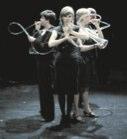
-
TAFEL
/ TAFEL
TAFEL is a project that takes a journey and an imaginary conversation between the two main Belgian cultures: Walloon and Flemish. While listening to interviews with Belgian politicians, the audience sees two tables floating in a lake. Two tables like the two divided cultures, different social policies that are often incomprehensible.
TAFEL is an excuse to take up these questions and to reflect on some invisible differences and separations. TAFEL takes us back to two places and exemplifies a forced union of elements that are physically alike but culturally distinct. It shows the differences and similarities between two worlds, two languages; a place that bears a single name, but is divided by invisible walls. A place that is based on the same foundation but at the same time separated by a fissure.
Director/author: Enrique Ramirez
France 2011
Installation min.
-
THE CHARACTER
/ THE CHARACTER
Fifteen children (aged between 11 and 16) from the Gundecha Education Academy (a school located in the suburbs of Mumbai) were each asked to watch a Bollywood movie prominently featuring a child character. During the shoot that followed, each of the fifteen participating children was interviewed individually: the questions asked promted each child to verbally portray the fictional child in the movie that s/he had watched. As they describe fifteen fictional children from the big screen, the fifteen children portrayed in The Character offer a range of insights into the role played by ‘the child’ (as character and as spectator) in mainstream Indian cinema.)
Director/author: Candice Breitz
South Africa 2011
Installation min.
-
THE IRREVERSIBLE
/ THE IRREVERSIBLE
"the irreversible" is a part of project "para-"(working title) that experiments in time-axis and parallel world. A sequence of 1024 videos of 2 seconds of explosion is being rewound on the screen. Each explosion occurs in different condition of parameters and constants. The video is prerecorded and the audience can recognise that because of rewinding of irreversible phenomenon that's impossible to operate inverse.
Director/author: Norimichi Hirakawa
Japan 2011
Installation min.
-
THE MACHINE
/ THE MACHINE
When I think about my childhood, I remember not only ready-made toys, but also selfmade toys, things made out of fantasy, and I remember of course playgrounds. They already have a Gameboy and know how to play with the Nintendo Wii, but at the same time I also see that they hardly play with other children and barely create their own toys or visualize an imaginary scenery to act and play in. They don’t put a blanket over a chair and imagine it being cave. They have never played with paper planes, they rarely go to playgrounds or play with other children. Rope skipping is a game they and many other children at their age mostly have not heard of, let alone ever played yet.
Director/author: Marc Tobias Winterhagen
Poland 2011
Installation min.
-
THE TENTH SENTIMENT
/ THE TENTH SENTIMENT
A model train equipped with a light source slowly navigates through various household objects lined on the floor, and projects their shadows. Dancing on the walls, floor, and ceiling of the room, the shadows of the objects keep changing like a landscape seen through the carriage windows, surrounding viewers with images as if they were passengers riding on the train. By exposing them to a repetition of conflicting experiences—immersion and bird’s eye view, déjà vu and jamais vu—this work sharpens audiences’ senses and inspires them to share impressions.
This attractive work has a simple system that puts the spotlight on spatial exposure. Unlike cliché interactive art works that tend to depend too much on technology, The Tenth Sentiment is a realisation of “interaction” seen as a direct and versatile of the work by its viewers.
Furthermore, it can also be interpreted as part of the history of imaging machines and a step into developing new horizons. The work is related to the ancient shadowgraphs, 17th century magic lanterns, moving pictures, and the experiments of László MOHOLY-NAGY (Hungarian photographer, painter and art educator) with light and shadow. At the same time, it attains an innovative spatial and dynamic first-person sensitivity by allowing audiences to project themselves into the composition and to attain the perspective from the train, through the movement of the light source, in addition to looking down on the world.
By creating a unique universe through this example of self-made “Device Art”, KUWAKUBO reveals a new world that transcends the boundaries of installation, interactive art, visual images and performance, and redefines the origins of media.
Director/author: Ryoto Kuwakubo
Japan 2011
Installation min.
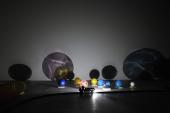
-
THE WAY TO SUCCESS
/ THE WAY TO SUCCESS
On a superficial level The Way to Success is supposed to be seen as a motivational film promising success in life and business. On a deeper level it questions the striving for power, beauty and success in today’s society and puts the viewer to the test on how much he accepts to be true.
The film is put into scene in the style of a documentary fiction film. Acted scenes are sequenced by informational 3D graphics and voiced over by a narrator.
Director/author: Michael Gülzow
Germany 2011
Installation min.
-
UNDER THE CENTIPEDE SUN
/ UNDER THE CENTIPEDE SUN
A portrait of a no man’s land: burnt and sterile, the landscapes contain the traces of an invisible war. While still fresh in these places’ memories, this unknown war is like a demon from the past which has left its marks all over the place, creating post-destruction sculptures. There are no human combatants, only machinery; some of it lying dead, like a scar on the landscape, some caught in a mysterious choreography. This theater of post-destruction takes place in an almost unearthly landscape, beautiful and barren. The geography changes, it mixes with an artificial post-traumatic topography.
Director/author: Mihai Grecu
France 2010
Installation min.
-
UNTITLED
/ UNTITLED
The new short fiction film by Nicolas Provost is made completely out of stock footage. This is normally used as illustrative material in a very sober way. Provost wants to show that stock footage can have an aesthetic and cinematic value and that it can tell a story. The film starts with an off-screen dialog between a young couple, ready to embark on a romantic adventure. What happens next? Provost tells their story using nothing but stock footage exterior shots of a Boeing plane flying towards a sunset.
Director/author: Nicolas Provost
Belgium 2010
Installation min.
